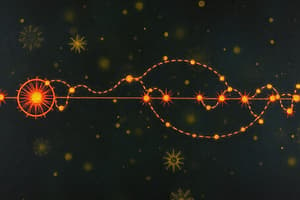Podcast
Questions and Answers
What is the primary function of the electron transport chain?
What is the primary function of the electron transport chain?
- To metabolize energy-rich molecules to form CO2 and H2O
- To oxidize NADH and FADH2 (correct)
- To synthesize ATP from ADP and Pi
- To reduce coenzymes NAD+ and FAD to form NADH and FADH2
What is the net result of oxidative phosphorylation?
What is the net result of oxidative phosphorylation?
- The synthesis of ATP from ADP and Pi (correct)
- The metabolism of energy-rich molecules to form CO2 and H2O
- The reduction of coenzymes NAD+ and FAD
- The production of NADH and FADH2
What is the role of NADH and FADH2 in the electron transport chain?
What is the role of NADH and FADH2 in the electron transport chain?
- To metabolize energy-rich molecules to form CO2 and H2O
- To donate electrons to the electron transport chain (correct)
- To receive electrons from the electron transport chain
- To synthesize ATP from ADP and Pi
What is the byproduct of the metabolism of energy-rich molecules?
What is the byproduct of the metabolism of energy-rich molecules?
What is the location of the enzymes responsible for electron transport and oxidative phosphorylation?
What is the location of the enzymes responsible for electron transport and oxidative phosphorylation?
What is the term for the process by which ATP is synthesized from ADP and Pi?
What is the term for the process by which ATP is synthesized from ADP and Pi?
What is the energy-rich molecule that can donate a pair of electrons to the electron transport chain?
What is the energy-rich molecule that can donate a pair of electrons to the electron transport chain?
What is the outcome of the electron transport chain?
What is the outcome of the electron transport chain?
What is the role of cytochromes in the electron transport chain?
What is the role of cytochromes in the electron transport chain?
Which complex in the electron transport chain does not produce ATP?
Which complex in the electron transport chain does not produce ATP?
What is the result of the electrochemical gradient across the inner mitochondrial membrane?
What is the result of the electrochemical gradient across the inner mitochondrial membrane?
What is the purpose of the proton gradient in the electron transport chain?
What is the purpose of the proton gradient in the electron transport chain?
What is the byproduct of the electron transport chain that accumulates in the intermembrane space?
What is the byproduct of the electron transport chain that accumulates in the intermembrane space?
What is the chemical gradient generated across the inner mitochondrial membrane?
What is the chemical gradient generated across the inner mitochondrial membrane?
What is the electron transport chain located in?
What is the electron transport chain located in?
What is the purpose of the ATP synthase complex?
What is the purpose of the ATP synthase complex?
What are the two components of the electrochemical gradient?
What are the two components of the electrochemical gradient?
Study Notes
Electron Transport Chain (ETC) and Oxidative Phosphorylation
- Mitochondria contain the enzymes responsible for electron transport and oxidative phosphorylation.
- Energy-rich molecules are metabolized to form CO2 and H2O, producing metabolic intermediates that donate electrons to specific coenzymes (NAD+ and FAD) to form energy-rich reduced coenzymes (NADH and FADH2).
Electron Transport Chain
- Electron transport chain (ETC) or respiratory chain (RC) oxidizes NADH and FADH2, releasing energy used for ATP synthesis through oxidative phosphorylation.
- The ETC consists of four electron transport complexes in the inner mitochondrial membrane:
- Complex I: NADH-CoQ reductase (produces ATP)
- Complex II: Succinate CoQ reductase (no ATP produced)
- Complex III: CoQ- Cytochrome C reductase (produces ATP)
- Complex IV: Cytochrome C oxidase (produces ATP)
Cytochromes
- Cytochromes are proteins with bound heme, each with a different reduction potential.
- The iron atoms in cytochromes are in Fe3+, reduced to Fe2+ when accepting electrons, and reoxidized to Fe3+ when passing electrons to the next component.
Mechanism of Oxidative Phosphorylation
- During the ETC, H+ are released into the intermembrane space, creating an electrochemical gradient across the inner mitochondrial membrane.
- The electrochemical gradient consists of:
- Electrical gradient (more positive charges outside the membrane)
- Chemical gradient (pH gradient, with lower pH outside the membrane)
- This H+ gradient (Proton Motif Force) is used by ATP synthase complex to make ATP via oxidative phosphorylation.
Studying That Suits You
Use AI to generate personalized quizzes and flashcards to suit your learning preferences.
Related Documents
Description
This quiz covers the electron transport chain and oxidative phosphorylation, including the role of mitochondria, energy-rich molecules, and electron donation.



